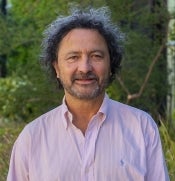ASU researchers involved in scientific breakthrough unveiling method to distinguish 'mirror-image' molecules

A depiction of the amino acid alanine, important for energy in the body. Researchers have developed a new technique to tell apart "mirror-image" molecules, which could lead to safer medicines and advances in science. Graphic courtesy of ASU's School of Molecular Sciences
An international team including researchers from Arizona State University and University of California, Los Angeles has made a significant breakthrough in molecular science, potentially transforming how scientists can study chiral molecules — those that exist in two mirror-image forms, like left and right hands.
This advancement could be helpful for making safer medicines and revolutionizing fields such as pharmaceuticals, electronics and biological research by enabling more precise molecular analysis.
Published in Nature Communications, the study introduces a new technique for distinguishing between chiral molecules using nuclear magnetic resonance (NMR), a key tool in chemistry, biology and medicine.
NMR examines how atoms respond to magnetic fields, offering insights into molecular structures. Historically, it was believed that NMR could not differentiate between chiral molecules, which are crucial in various biological processes due to their distinct, often opposing behaviors despite their similar structures.
In the pharmaceutical industry, for example, one form of a chiral molecule could be therapeutic, while the other might have harmful effects.
However, the research team has demonstrated that NMR can indeed distinguish between these molecules using an innovative technique applied to solid materials.
“This is a paradigm shift,” said Vladimiro Mujica, professor in ASU’s School of Molecular Sciences who is a co-author on the research. “For years, the scientific community thought this was impossible, but we’ve proven that NMR can detect these subtle differences.”
The breakthrough holds significant implications for drug development, allowing for a more precise understanding of molecular behavior. Combining theoretical models with experimental results, the study reveals new ways magnetic fields interact with molecules.
The multi-institutional team, which includes researchers from UCLA, ASU, Penn State, TU Dresden in Germany and MIT, focused their findings on the concept of chirality-induced spin selectivity (CISS).
This controversial yet promising idea connects NMR’s molecular detection capabilities with the CISS effect, opening new avenues for detailed molecular studies.
“We discovered that the coupling between nuclear spins varies depending on whether a molecule is left- or right-handed,” said Louis Bouchard, corresponding author and UCLA professor of chemistry. “The strength of this coupling differs between the chiral forms, and this finding could enable selective probing of molecules based on chirality.”
As the team advances NMR technology, future research promises new applications in medicine, electronics and more.
“This breakthrough could lead to more accurate drug development, advancements in material science and deeper insights into biological processes,” Mujica said. “Our model and results have been rigorously tested and validated, despite initial skepticism.”
Louis Bouchard of University of California, Los Angeles and Gianaurelio Cuniberti of TU Dresden in Germany are corresponding authors of the paper. School of Molecular Sciences Postdoctoral Scholar Mario Galante was also involved in this study.
More Science and technology

Diagnosing data corruption
You are in your doctor’s office for your annual physical and you notice the change. This year, your doctor no longer has your health history in five-inch stack of paperwork fastened together with…
Large-scale study reveals true impact of ASU VR lab on science education
Students at Arizona State University love the Dreamscape Learn virtual reality biology experiences, and the intense engagement it creates is leading to higher grades and more persistence for biology…

ASU-led space telescope is ready to fly
The Star Planet Activity Research CubeSat, or SPARCS, a small space telescope that will monitor the flares and sunspot activity of low-mass stars, has now passed its pre-shipment review by NASA.…



